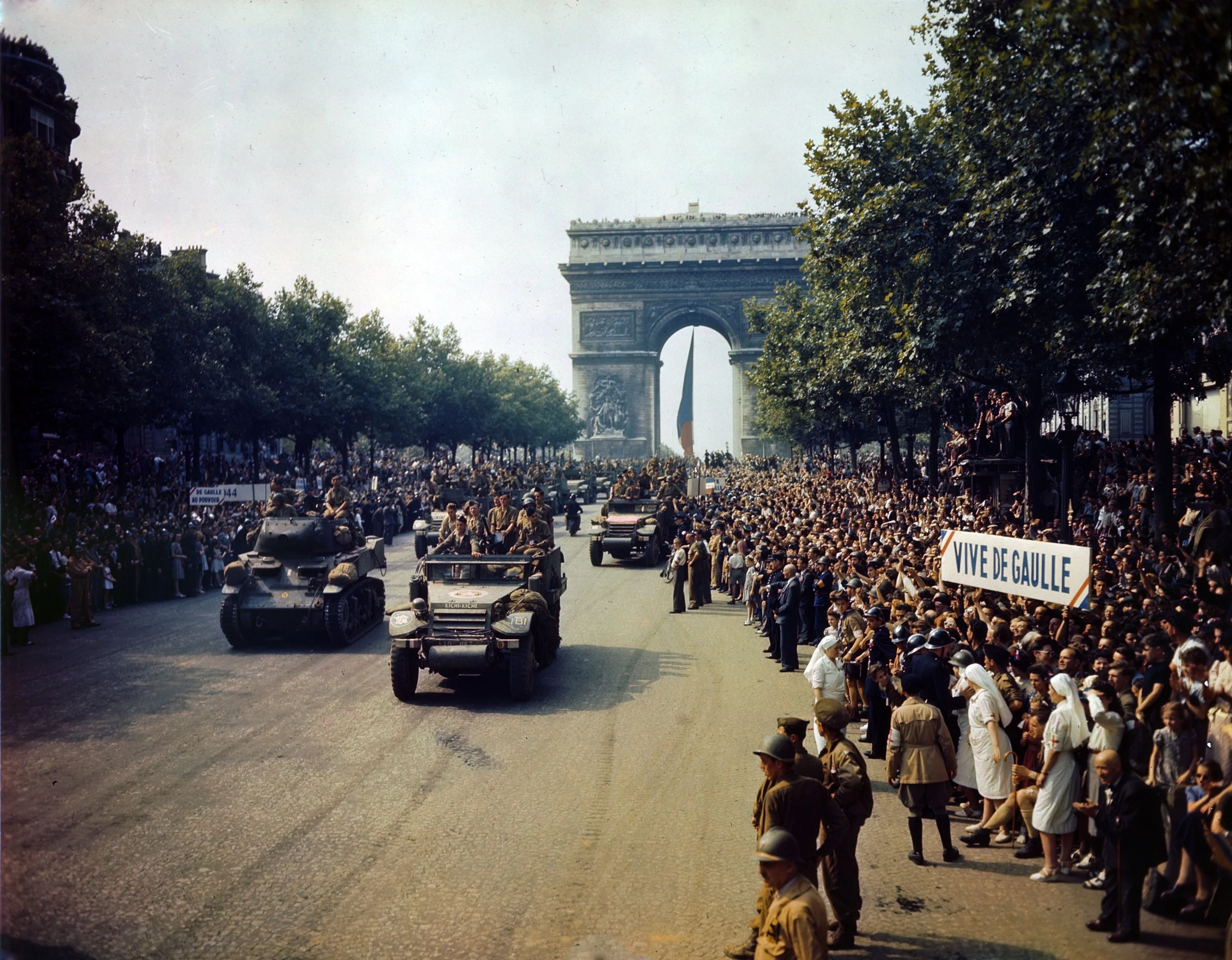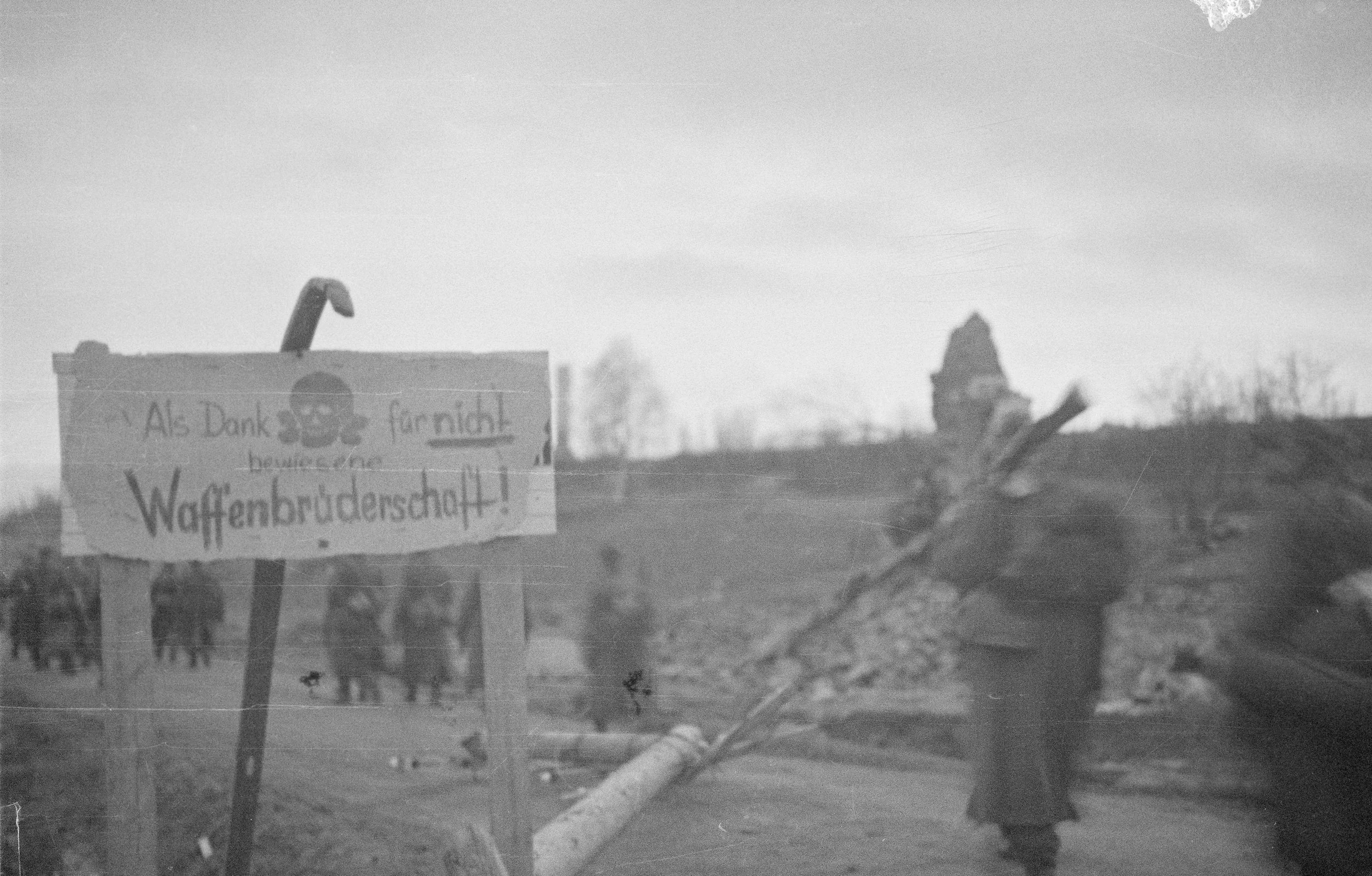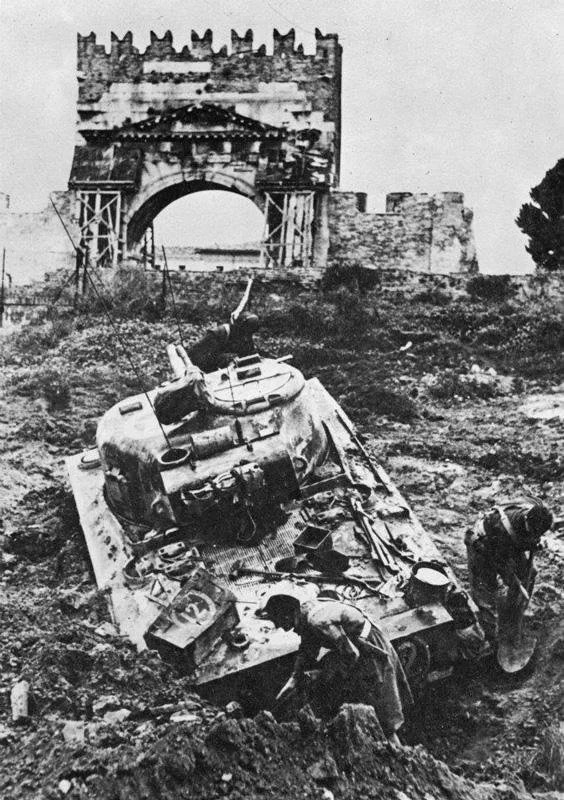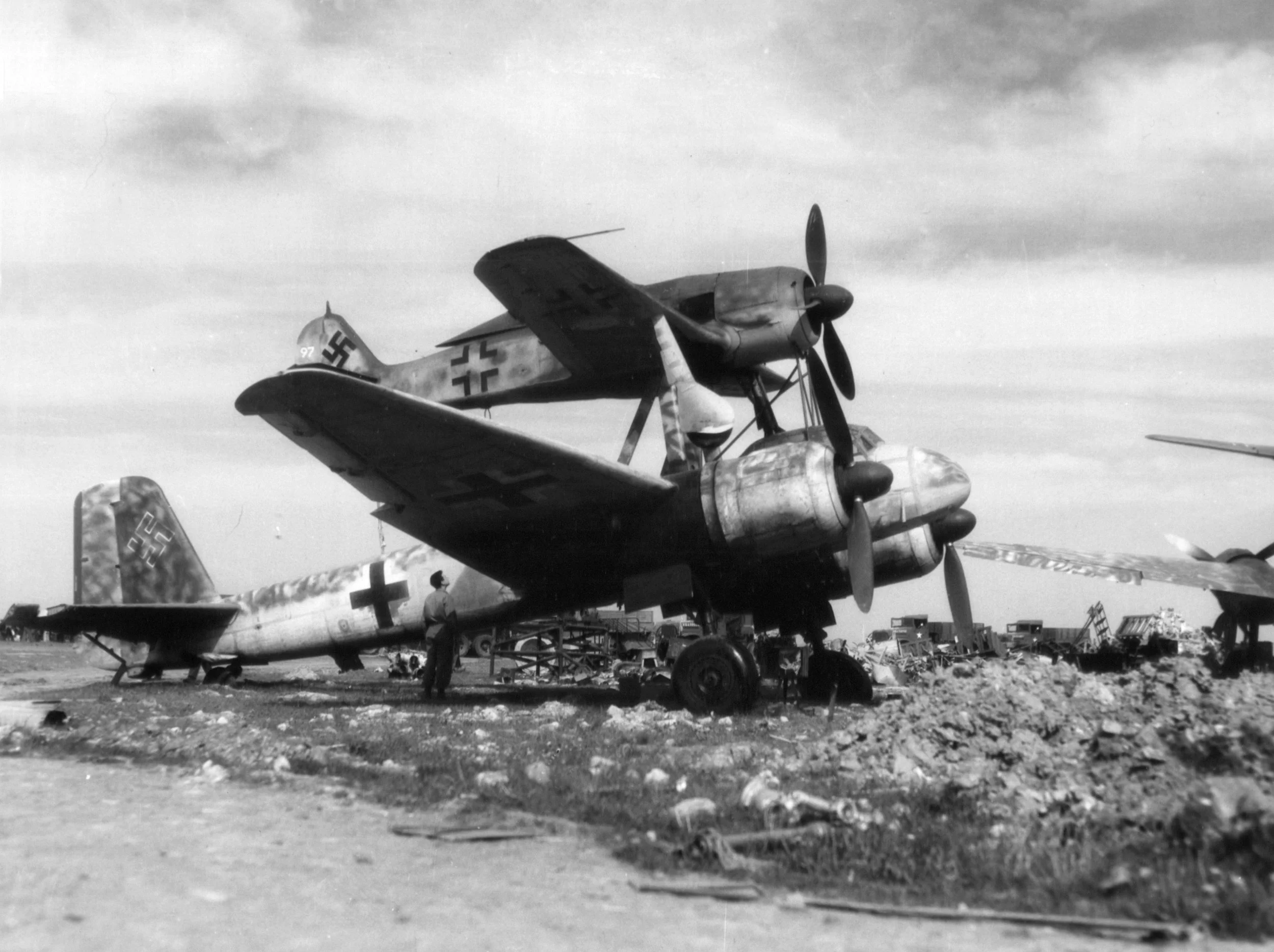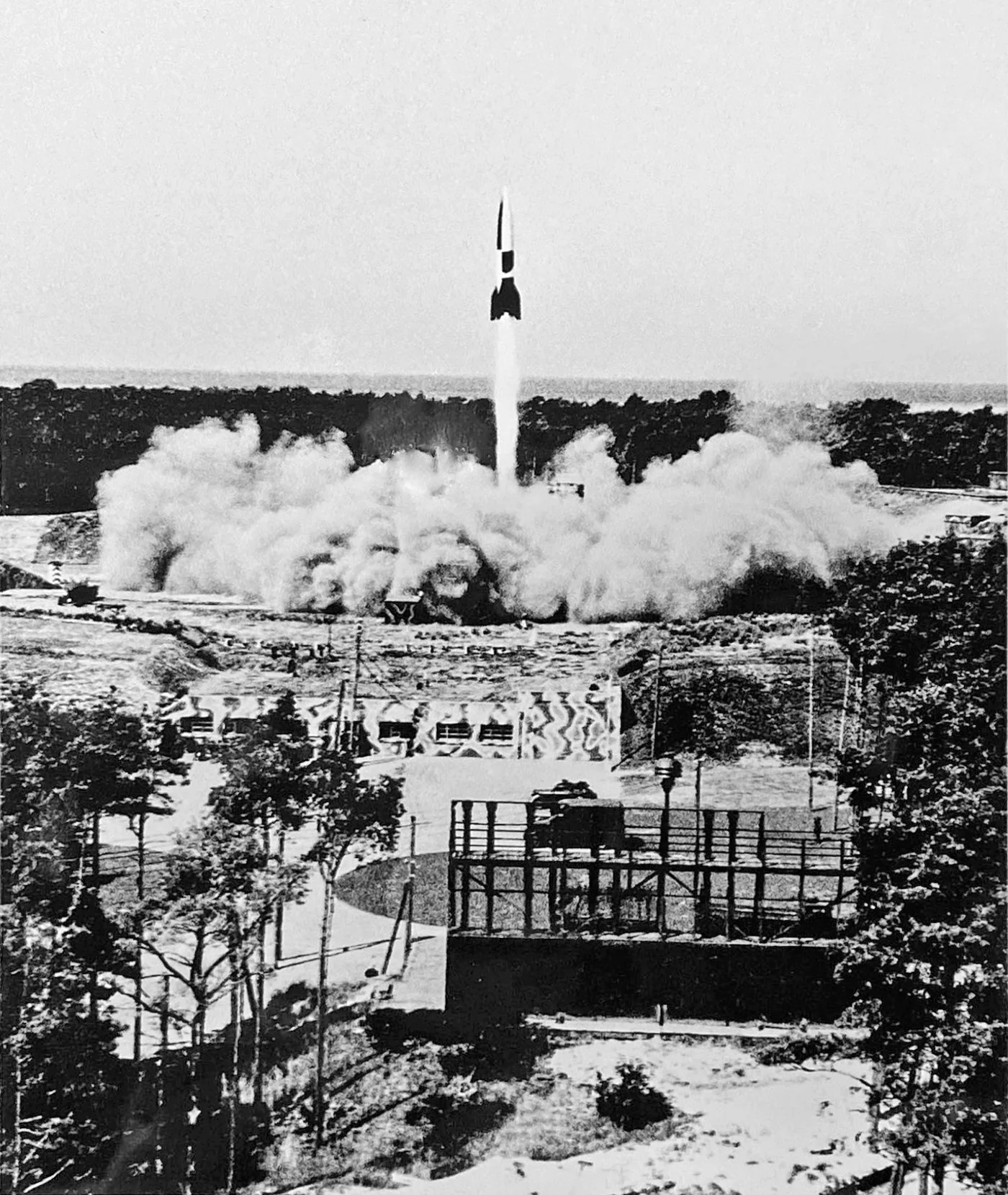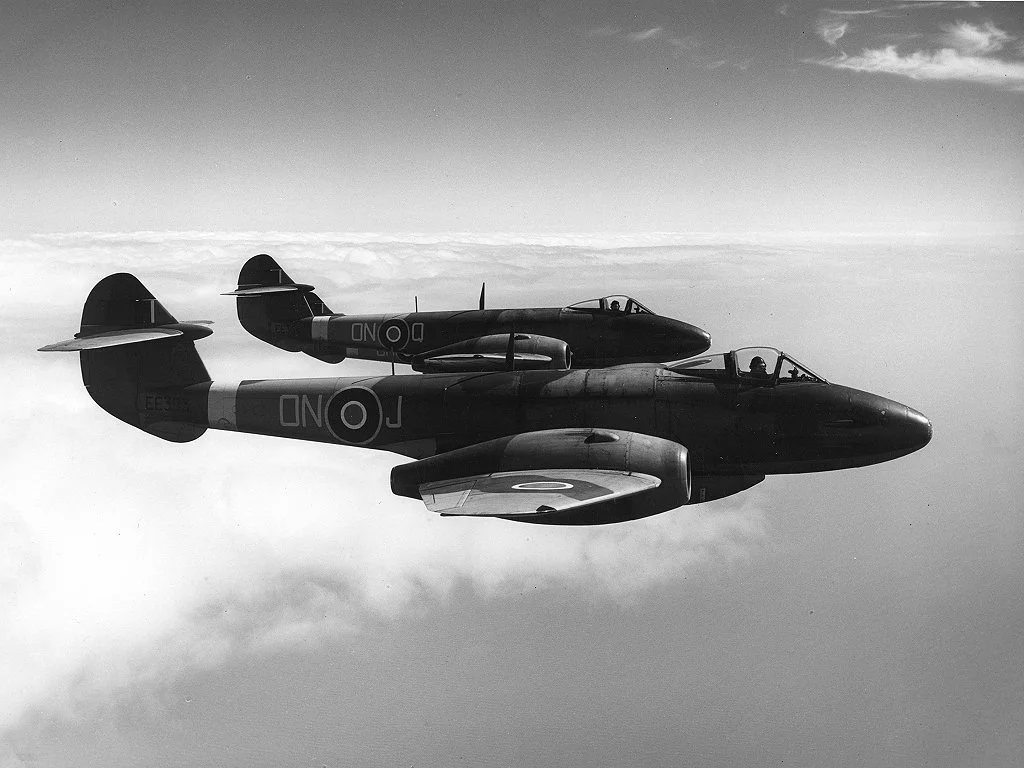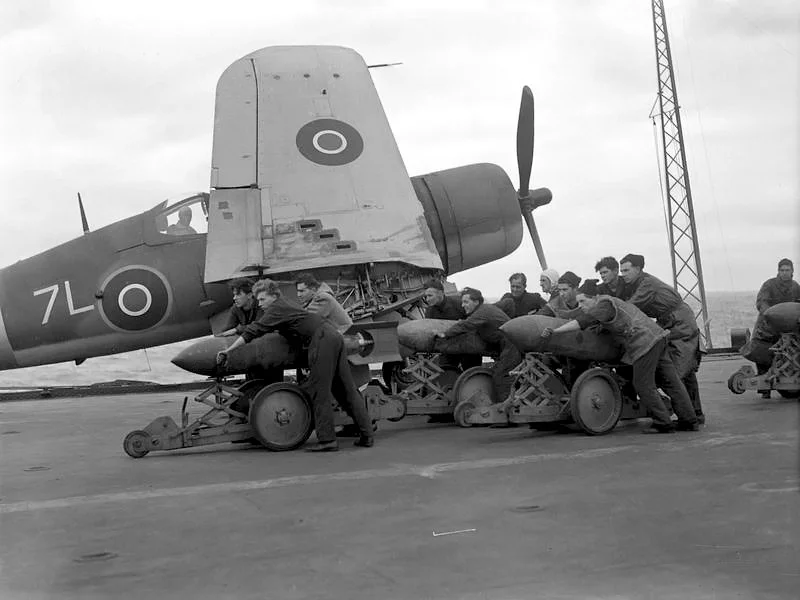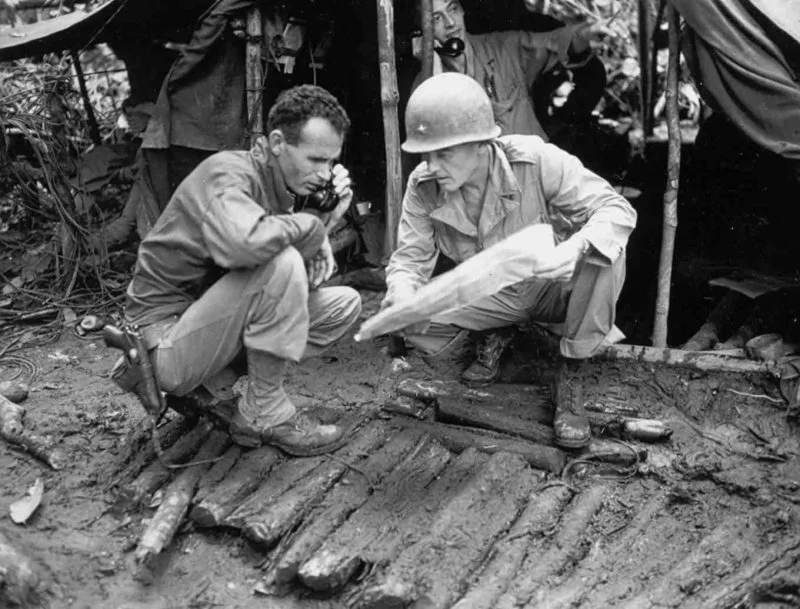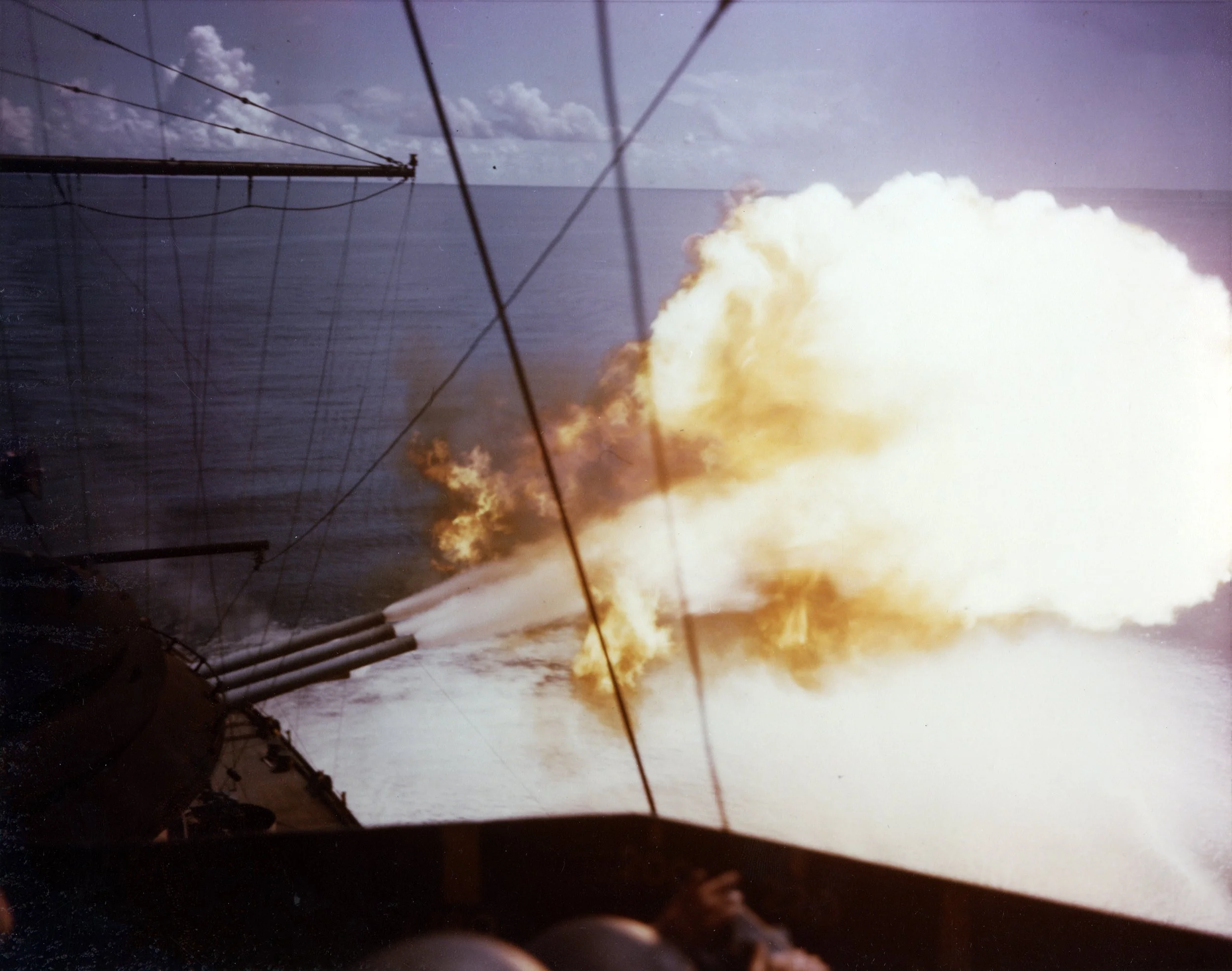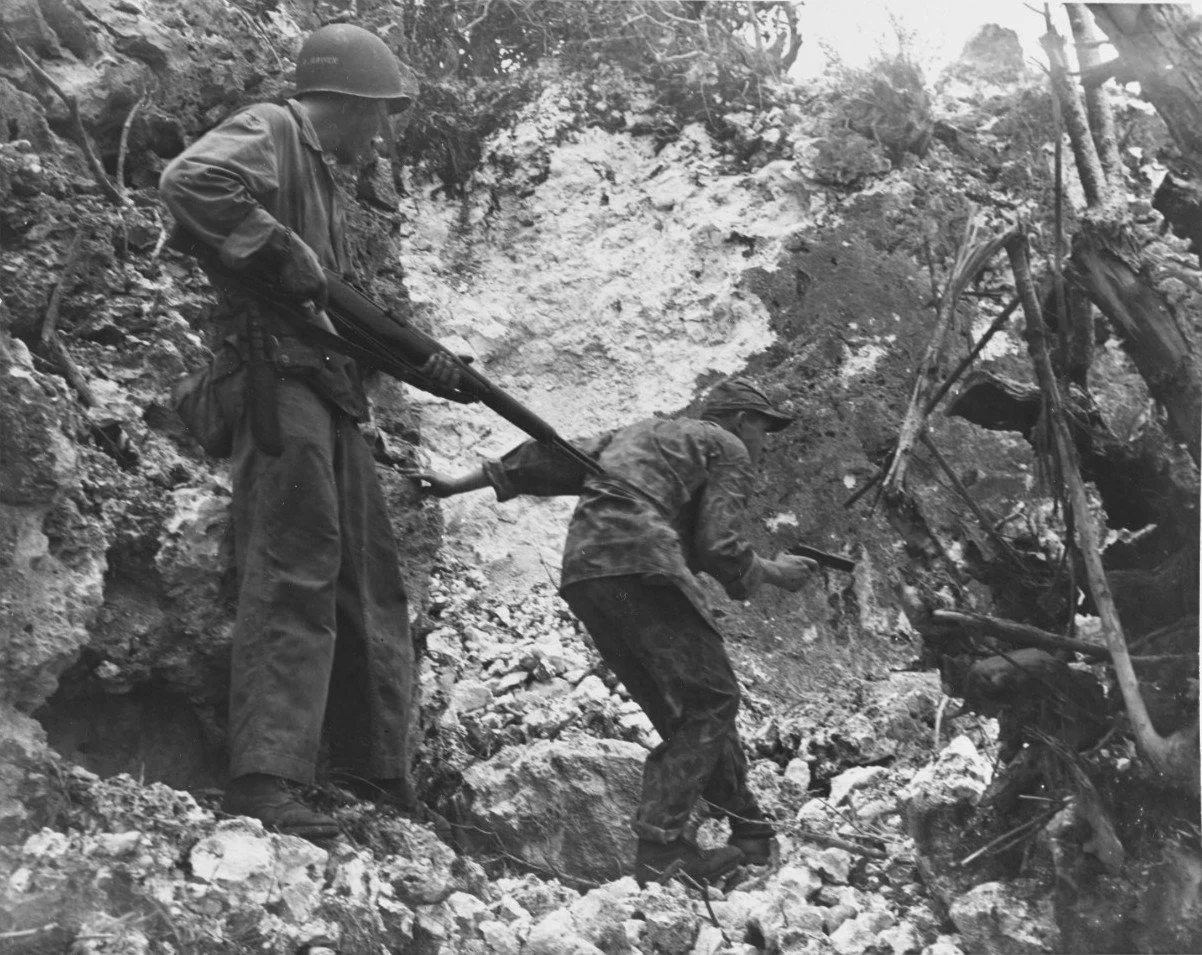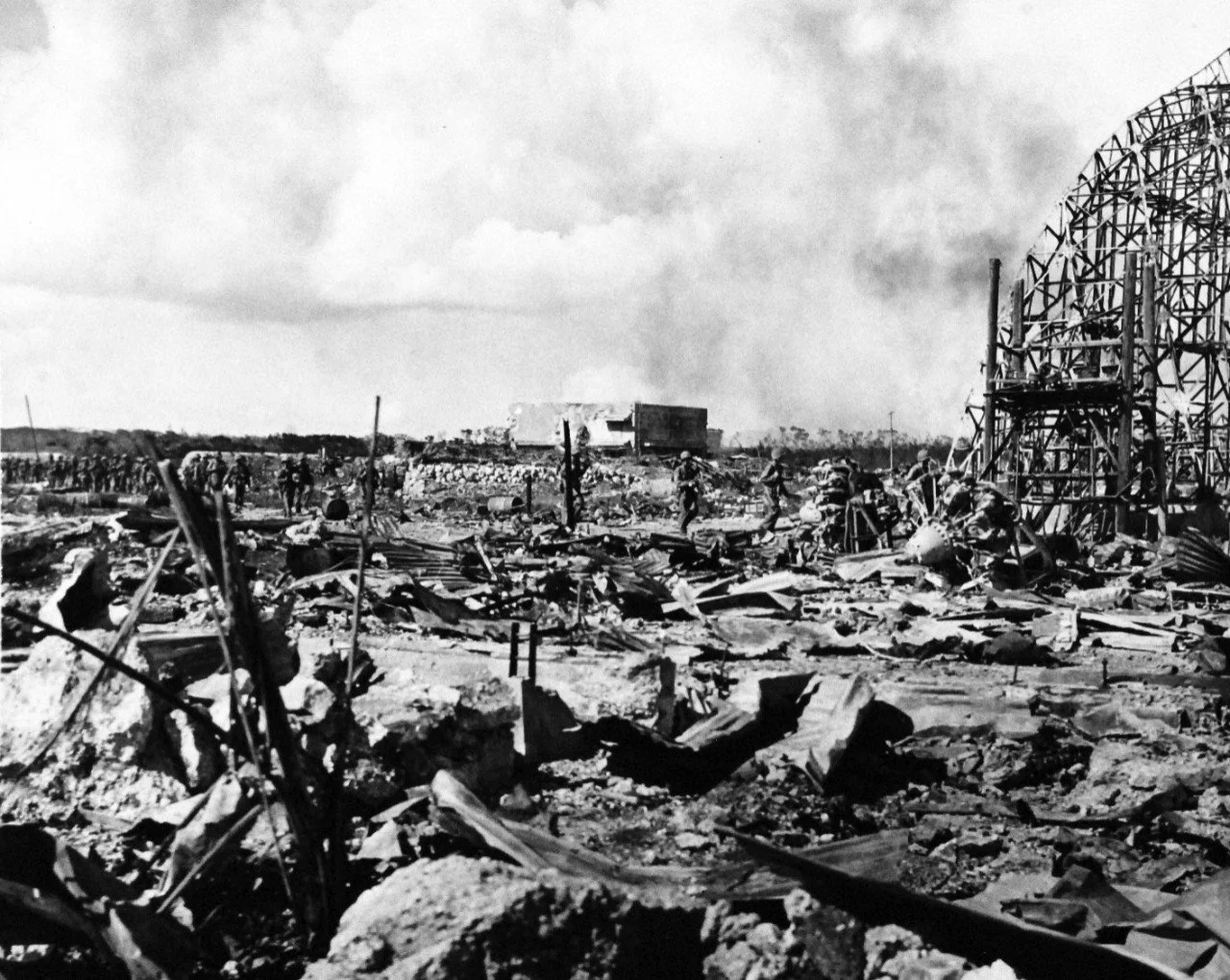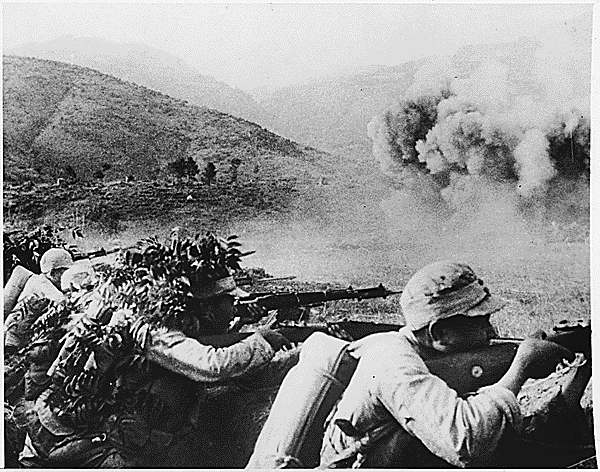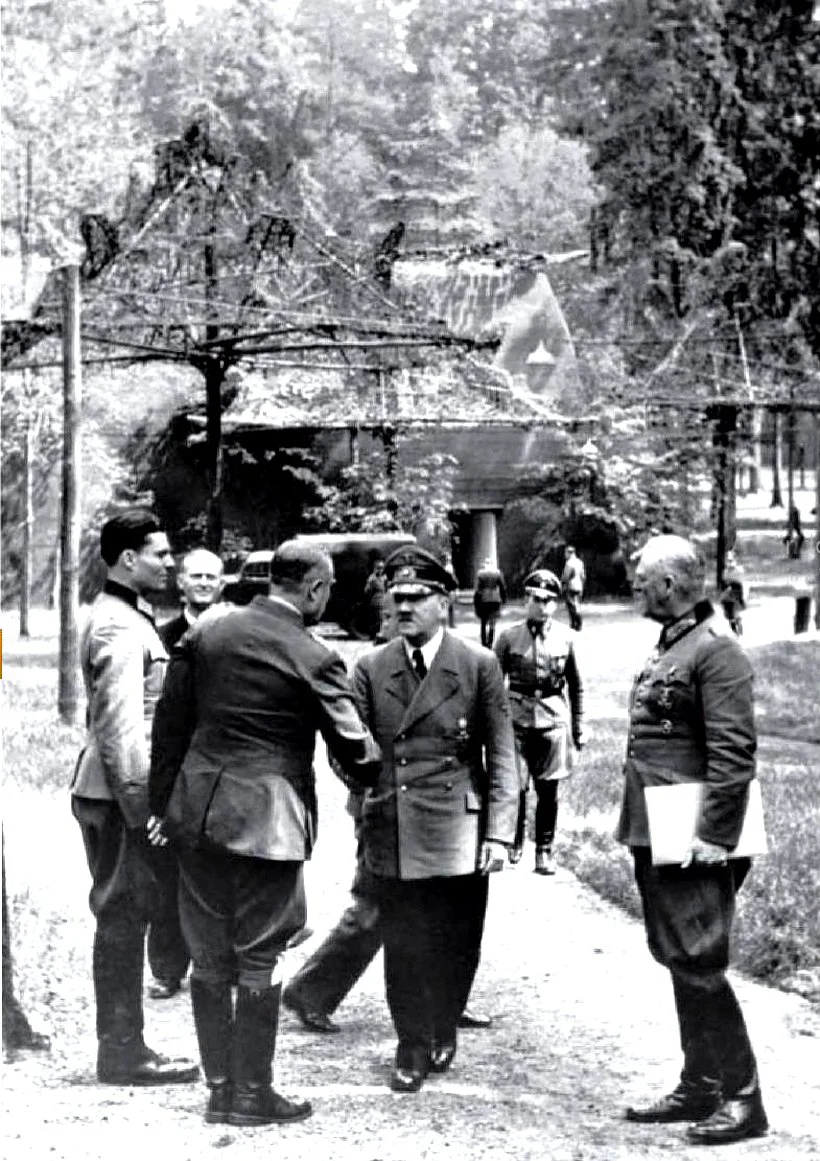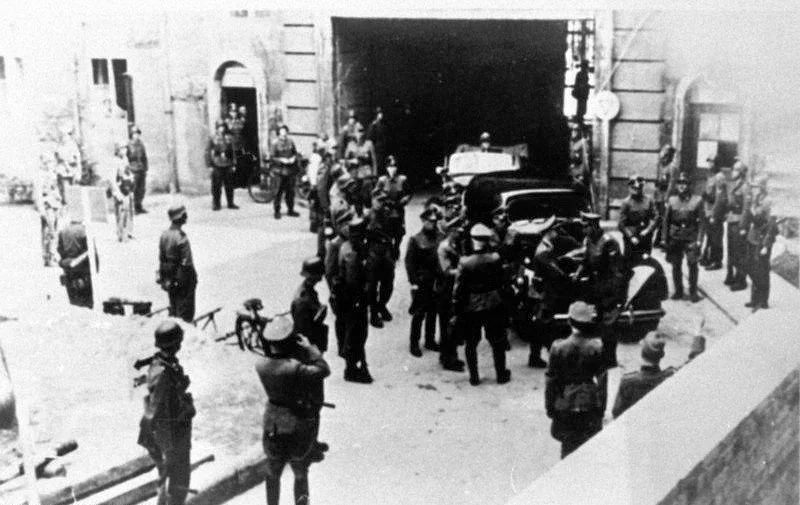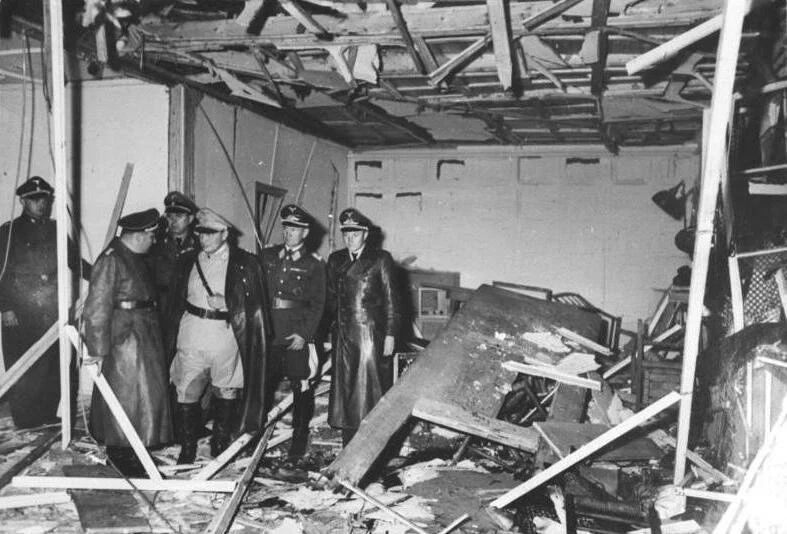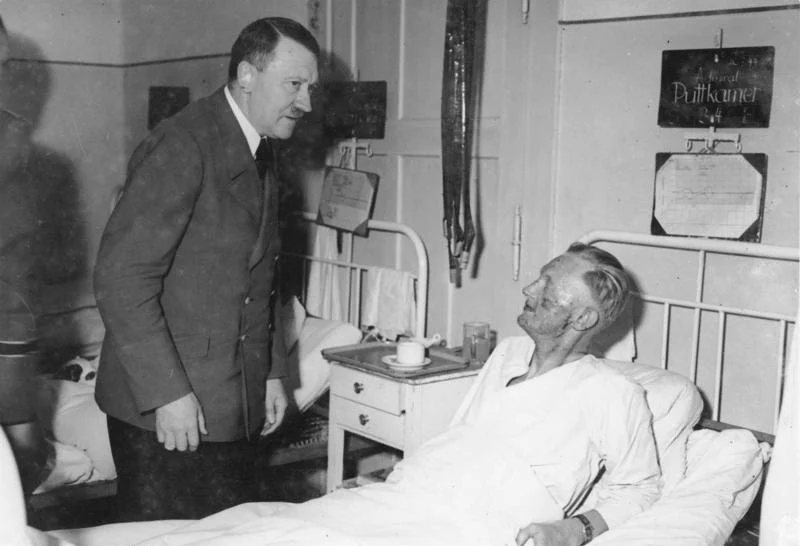Summer, 1944
Chapter 35
Libération
July - September
Europe: The Western Front
A British PIAT crew in position near Caen
British Army
Following the initial success of the landing phase of Operation Overlord, the Allies moved quickly to consolidate and expand their beachheads and penetrate deeper into France. The initial goals of the Americans after landing at Omaha and Utah Beaches was to press to the southwest and cut off the German forces on the Cotentin Peninsula, followed by a thrust northwestward to clear the peninsula and secure the port of Cherbourg. The British and Canadians, coming from Gold, Sword and Juneau Beaches, was to take the city of Caen and its environs.
British soldiers in position along a roadside in Normandy
British Army
Caen, located nine miles inland from the coast, was the main road, rail and communications hub of the Normandy region, and as such was a critical objective of the invasion as well as a major German headquarters. Unable to take the city on D-Day, the Allied forces tried again on 10 June, but this was halted by the Germans after heavy fighting around Villers'-Bocage, with a withdra wal on 13 June. Attacks resumed again with Operation Epsom on 26 June, this time driving southward to the west of Caen. Despite heavy casualties, Epsom was successful in penetrating the German lines, and moving toward enveloping Caen.
British infantry move up with a Churchill tank during Operation Epsom
British Army
To the West, the American offensive moved quickly, securing the town of Carentan and slamming across the Cotentin Peninsula despite a heavy German counterattack at Hill 30 near the town. Heavily engaged around the Caen, the German units in Normandy were consistently unable to adequately reinforce in the American sectors, and crumpled in the face of a fast US advance. The Peninsula was isolated by 18 June, and within two days the Americans were at the gates of Cherbourg. Ground assault of the city commenced on 22 June, supported by the heavy guns of US Navy warships off shore, engaging in gunnery duals with reinforced German coastal batteries. The exhausted German garrison quickly began to collapse, with organized resistance ending on 29 June. Despite this victory, however, the Germans had managed to cause significant damage to the port facilities, and it would be months before it could be made operational.
American troops march a column of German prisoners out of Cherbourg
US Army
Around Caen, the British and Canadians continued their attacks through July, with the major strongpoint at the Capriquet airfield being taken by the Canadians from stiff SS defenders mid-month, allowing the Allies to form a pincer to the sotuh and east of the city itself. Several shakeups in the German High Command during this period would take place, while Allied heavy bombers pummeled the city and its defenders. By 19 July the city had been taken, and major German counterattacks to the south were repulsed as the line stabilized, with the Canadians being unable to capture the strongpoint at Verrières Ridge on 25 July.
A view from an RAF Typhoon during a strike on Capriquet Airfield
Royal Air Force
Meanwhile, the Americans had been engaged in heavy fighting around the crossroads town of St. Lo. Vicious fighting had been occuring in the hedgerows of the Bocage country surrounding the area, with the tall, thick hedges forcing tanks and infantry to operate along confined paths with many options for concealment of the German defenders. Pushing into the town, one American unit found itself isolated and surrounded, but was eventually able to break out using grenades and bayonets when ammunition was depleted. When their commander, Major Thomas Howie, was killed by German mortar fire, his men placed his flag-draped body on the hood of a jeep, ensuring that he would lead his men into St. Lo as they entered the city. The body was placed on the rubble of the St. Croix Cathedral after the city was secured, by this point nearly totally destroyed by bombardments and named “The Capitol of Ruins” in the popular imagination.
US Infantry enter St. Lo
US Army
Following the capture of St. Lo, the Americans launched Operation Cobra to break out of the Normandy Bocage, driving against the Germans just as they were reeling from the loss of Caen on 25 July. Operating in close cooperation between infantry, artillery, armor and air support the American assault mirrored the effective German blitzkrieg of 1940, finding the German defenders scattered into various strongpoints and battered by air raids. German reinforcements on 28 July engaged fresh American units rolling in from the beaches, but the Panzer forces found themselves being decimated en route to the field by USAAF and RAF strike fighters. By the end of July, the Americans were beginning to break out of the Bocage into the open country, as additional offensives were launched by the British and Canadians.
US troops advance through a gap in the hedgerows of the Bocage
US Army
With the smashing of the German lines near St. Lo, in the east Operation Bluecoat was launched to break out from Caen by the Anglo-Canadian forces as the Americans drove into Brittany. As the fighting continued, it became apparent that the Germans were being pressed toward the town of Falaise, and even as pincers of Allied forces began to appear, the Fuhrer continued to order his forces to stand and fight around Falaise. On 21 August the Allied forces met in Chambois with after Falaise was taken by Canadian troops, and the German Army Group B was isolated within. The Germans desperate attempts to escae via Chambois resulted in terrible fighting, as did their failed attempts to rest Hill 262 (Mont Ormel) from Free Polish forces holding it. The retreating Germans crossing the River Dives, choked as it was with the corpses of their comrades and the twisted wrecks of panzers and other vehicles.
A devastated German column near Chambois
Polish Army
This spectacular cap the Allied success in Normandy saw the destruction of forty German divisions, with almost a half million men killed and captured. Following an uprising by the local resistance, the Germans declared Paris an open city (in defiance of the orders of the Fuhrer to destroy it and fight to the last among the ruins), with American and French forces parading along the Champs Elysees on 26 August as the last German units in the sector retreated over the Seine.
Free French armor parades in Paris after the liberation of the French capitol
US War Department
While all eyes were on Normandy, another Allied invasion had occurred on the southern French coast. Operation Dragoon, unlike Overlord, met mostly reserve units and conscripted eastern europeans, and resistance was light along the beaches. The situation in the German rear echelon was in chaos, as a large scale uprising by French resistance crippled logistics and communications, and when counterattacks came against the beaches they were met with cast enemy superiority. By 17 August, even Hitler could see the writing on the wall, and ordered a general retreat of all German forces in France (with the exception of fortress units defending U-boat bases along the Bay of Biscay) to a new defensive line running to the Swiss frontier and near the Belgian border. Fighting in south continued, with the Germans making a stand at Marseilles and Toulon, and fighting rearguard actions as they retreated to the northeast.
Landing craft in southern France during Operation Dragoon
US Navy
The Allied forces from Normandy liked up with those advancing from the south on 12 September, and by early September the British had entered Belgium as the Americans crossed the western frontier of the Reich and reached the Siegfried Line. Heavy fighting began in the Hurtgen Forest in September, and in Metz in Alsace. The month of September would close out with the liberation of Calais on 30 September, pressing the Germans back toward the Belgian border along the Channel coast.
German anti-tank “Dragon’s Teeth” and a bunker along the Siegfried Line
German Federal Archives
Europe: The Eastern Front
As the Allies forced open the Western Front, the Red Army continued to exploit the breakthroughs achieved during Operation Bagration. In the north, the Soviets continued to maintain pressure on the Finns, with an aim to isolate southern Karelia, while concurrent operations captured Narva in Estonia, pushing the German frontlines farther from their Finnish allies. The situation was becoming increasingly perilous for Helsinki, and the Finnish government had previously noted that such a withdrawal from Estonia could force him to seek an armistice with Stalin.
Finnish infantry armed with German Panzerfausts pass a knocked out Soviet tank
Finnish National Archives
Alarmed by these developments, German Foreign Minister von Ribbentrop negotiated a deal for large shipments of infantry anti-tank weapons from Germany, and Hitler additionally ordered reinforcements to be sent from Norway to bolster the collapsing Finnish lines. As a result of this influx, the Soviets were halted by mid July, and at the Ilomantsi the Soviets were dealt a significant blow in mid August. Despite this, the Finnish Army was exhausted, and the political pressure resulted in the resignation of President Risto Ryti and his replacement with Army commander Field Marshal Mannerheim. Mannerheim promptly cancelled the agreement with Germany and sent an overture to Moscow requesting terms.
Finnish troops approach the Soviets under a white flag
Finnish Army
Stalin’s reply was a return to the post Winter War borders, breaking off all relations with Germany, demobilizing their armies and to militarily expel any German troops remaining in Finland by15 September, among others. This was agreed to on 2 September, with Finnish troops standing down two days later. Subsequent to the Finnish surrender the Germans made rapid attempts to evacuate their forces from the country for redeployment to other fronts, with seaborne evacuations taking place along Gulf of Finland as well as overland via Norway. Following an attempt by the Germans to seize Suursaari Island that was repelled by Finnish troops and VVS planes, and subsequently escalated into open warfare across the country as the Finns turned on their erstwhile allies in late September.
A German sign on a roadside in Finland, bitterly thanking the Finns for turning on their erstwhile allies
Finnish Army
Meanwhile, even as the Germans managed to stabilize the shattered frontlines after Bagration, the Red Army launched another new offensive into Romania in mid August of 1944. This attack shattered the German/Romanian frontlines and quickly saw the Axis’ Army Group South Ukraine split and begin to collapse, with the 6th Army (reconstituted after its annihilation in Stalingrad) being enveloped and destroyed. The Romanian forces, meanwhile began to collapse in the face of overwhelming Soviet forces. Faced with the rapid invasion and loss of huge swaths of territory, the Romanian King, Michael I, led a putsch to overthrow the ruling government of Prime Minister Ion Antonescu. In response the Germans attempted to occupy what remained under their control in the country, but met resistance as the Romanian Army switched sides. Outnumbered badly by the Soviet-Romanian forces, the Germans would be expelled from Romania by the end of August, most notably losing control of the vital oilfields of the country, which represented the largest source of fuel for the German war effort.
Romanian troops greet the Red Army as they enter Budapest
Romanian National Archives
The collapse of Romania led to a similar political crisis to the south, as Bulgaria declared neutrality and attempted to remove the German forces stationed there (an action the Germans agreed to, concerned that the Red Army might push to the Adriatic and cut them off in the Balkans). This proved insufficient to prevent a Soviet invasion, and by 8 September communist factions within the country launched an uprising that topped the government and declared allegiance with the USSR.
Bulgarian communists enter Sofia during the September Putsch
In addition to these collapses in the north and south, Soviet forces also crossed the border into Hungary in late September, and a Soviet-Bulgarian force entered Yugoslavia to cut off German forces in Greece.
Europe: The Italian Front
After the Fall of Rome the Allies in Italy continued to press their offensive northward from the city as Field Marshal Kesselring’s forces withdrew to their next defensive lines. As the Allies pressed through Tuscany, the Germans abandoned the city of Florence in mid July, destroying the bridges in the city as they did so, although there was some fighting in the suburbs.
A British officer in Florence shortly after the liberation of the city
Imperial War Museum
The Allied forces in Italy had been condensed, with units being withdrawn for Operation Dragoon in southern France, but despite this they were in position to begin assaults on the Germans’ Gothic Line in early August. This series of fortifications stretched across the peninsula at the foothills of the Apennine Mountains, and was a maze of bunkers and fighting positions that was hopped to repeat the success of the Gustav Line in holding up the Allied advance.
British troops advance with a tank destroyer toward the Gothic Line
British Army
Early engagements along the line met with German defensive success, with various attacks being blunted. Despite this, Canadian, Greek and New Zealand forces were able to penetrate to the city of Rimini in late September, capturing the airfield outside the city after heavy fighting before proceeding into the town itself, by now a sea of ruins. The Battle for Rimini was considered to be on par with the fighting at El Alamein for its ferocity by the veterans of the British 8th Army. Despite this victory, howver, the Germans were able to retreat behind another phase line, and the deadlock thus endured on the Italian Front.
A knocked out tank near Roman ruins at Rimini along the Gothic Line
Europe: The Air War
In the skies over Europe, the balance was shifting heavily in favor of the Allies as German bases and flak batteries in France were overrun and silenced. As the war continued, both sides were seen to deploy new weapons and technologies. The Luftwaffe’s ME262 jet fighters were joined by the new ME163 Komet rocket interceptors in late July, with these craft being arguably more dangerous to its own pilots than the Allied bombers.
An ME163 caught in the sights of a USAAF P47 fighter as it glides back to base after running out of fuel
US Army Air Force
More abnormal was the deployment of the “Mistel” over Normandy. This was a novel solution to the problem that Germany’s bomber force was growing increasingly outdated, and the general lack of air superiority on all fronts was leaving it nearly suicidal to sortie. The solution was to turn the planes themselves into massive bombs, which were guided in by an attached fighter before being launched like a massive missile against its target. Its massive warhead, weighing over two tons, made for a formidable weapon, although their slow speed rendered them easy to shoot down.
A German Mistel at a base in Germany
US Army Air Force
Finally, as the V1 attacks continued on England, the loss of increasing territory along the Channel Coast helped to push deployment of the newest of Hitler’s so-called Vengeance Weapons: the V2. This was the first true long range ballistic missile, powered by a rocket motor and became the first man-made object to enter space shortly before entering operational service with attacks on France and Britain in September of 1944. These were very powerful weapons, although their mechanical guidance made them unsuitable to tactical use on the battlefield, relegating them to terror attacks on cities, much like the V1.
A German V2 missile launching
German Federal Archives
While these developments were occurring, the RAF deployed the Glsoter Meteor, becoming the first and only Allied jet fighter to achieve operational status during the war. Deployed in the utmost secrecy, it was used to intercept V1s over Britain and was expressly forbidden to operate over enemy territory for fear that one could be shot down and captured by the Germans.
RAF Meteor jet fighters
Royal Air Force
Europe: The War at Sea
On the Atlantic, the Kriegsmarine made some abortive attempts to contain the two Allied invasions of France with limited effect. Destroyers clashed with their Allied counterparts off the Brittany coast in June, while attempts by E-Boats to interdict the Dragoon Landings in the south of France were a near total failure. Meanwhile, the Royal Navy launched another carrier strike on the battleship Tirpitz at its Norwegian anchorage, again with little result. Another engagement off France at Audierne Bay, saw a small British flotilla decimating a German convoy attempting to support the beseiged garrison at Brest.
Royal Navy Crews move ordinance past a Corsair fighter during preparations for a strike against the Tirpitz
Royal Navy
Europe: Under Occupation
As the German stranglehold on continental Europe began to rapidly collapse, uprisings began to occur across the continent. In France the resistance was becoming ever larger and more organized, and an uprising in Paris helped to force the Germans to abandon the capitol. In the east, the Polish Home Army began a series of large scale uprisings and rebellions against the Germans in cities across the country as the Red Army bore down on the German occupiers. In some cases they were successful, but as they met their Soviet “liberators” they found themselves disarmed and detained as agitators, finding the NKVD little different from the Gestapo.
Soldiers of the Polish Home Army in 1944
Elsewhere, the Germans continued their reign of terror, as the Nazis continued to round up and deport Jews and other so-called “undesirables” to the death camps in the east. In one particularly infamous episode, the refuge of the Frank family in a concealed attic in Amsterdam was raided by the Gestapo, resulting in the arrest and deportation of the entire family to the death camps. The only survivor of the family would later publish the diary of his daughter Anne, which would go on to become one of the most famous accounts of what was to be known as the Holocaust.
Anne Frank
Pacific: Southern Islands
In the sweltering jungles of New Guinea, the Americans and Australians continued their slog against the dug in Japanese. Additional amphibious landings took place in early July at Noemfor Island, with the objective of secure Japanese airbases built on it. Initial landings were unopposed as the Japanese retreated into the interior of the island, and the shellshocked defenders of the first airbase were swiftly overrun after naval bombardment. Subsequently the second base was taken, and airborne reinforcements were deployed as well. after failed counterattacks, the Japanese were slowly rooted out and destroyed in the jungles, with the last pockets being mopped up by the end of August.
American officers confer in New Guinea
At the end of July another landing took place along the Vogelkop Peninsula, with US troops landing along three beaches on the thirtieth. These were again unopposed, and it would be over two weeks before contact was made with the Japanese. The Vogelkop Peninsula was situated on the far western edge of New Guniea, and with its capture by American forces at the end of August General MacArthur himself landed at Sansapor there, with an eye toward the Philippines.
Elsewhere, the Japanese on the island of Biak were finally dislodged after onths of heavy fighting, allowing yet another domino to fall on MacArthur’s journey back to the Philippines. Development commenced immediately on supply bases to support the drive farther northward, while the Japanese initially attempted to direct powerful air and naval reinforcements to launch a counterattack to reclaim the island, although this would be cancelled due to loss of the more important Saipan.
American troops pass knocked out Japanese tanks
Another long battle that came to an ent was that for Lone Tree Hill along the northern coast of central new Guinea. The Japanese here had been entrenched since mid May, and when the position was taken in early September it allowed the capture of the Japanese airbase at Wakde, and allowed the nearby Maffin Bay to be used to stage future operations in the region. In the same vein of establishing bases, US forces also landed on Morotai in mid September, quickly overrunning the small Japanese garrison stationed there. Significant reinforcement was ordered, and the Japanese command in the Philippines dispatched troops to land and retake the island, with the first arriving just before the close of the month.
Pacific: Central Islands
A US battleship bombards Guam before the American landings begin
Capitalizing on their victory on Saipan, the Americans continued to push through the Marianas Islands. The next major landing took place on 21 July, as US forces began their liberation of Guam. A pre-war US possession, Guam had fallen under Japanese control during the initial surge of conquest following Pearl Harbor and subject to occupation and attempts to Japanize the population since then, although the attempts to bring them into the fold had given way to brutal military rule by mid 1944.
The Stars and Stripes return to Guam
The Americans made their landings at two beaches on the island’s west side, planning to form a pincer to envelop and capture the harbor at Apra to allow for reinforcements to land. This was accomplished despite Japanese counterattacks, including Japanese armor. These were ineffective, however, as they found themselves hopelessly outclassed by the American Shermans. After destroying the main Japanese force on the Orote Peninsula, the remnants of the defenders pulled back to the north, hoping to make a prolonged stand in the mountainous jungles at the heart of the island. Their lines their broke in mid August, and by the end of the month organized resistance on Guam had ceased, as the Stars and Stripes were formally raised over the island once again.
US Marines clearing caves on Guam
Meanwhile, on 21 July American forces landed on the island of Tinian, adjacent to Saipan. This operation had been delayed by the stiff resistance on Saipan, but as a result of this wait the invasion force was in range of supporting artillery from land based batteries on the island. Initial landing waves encountered limited resistance, and reduced what strongpoints they encountered fairly quickly. Stronger Japanese forces launched counterattacks soon after, but were beaten back with heavy casualties on both sides. The following day the Marines pushed out from their beachheads, capturing the airfield at Ushi Point and enveloping the Japanese on Mount Maga, and by the end of July had taken the main settlement of San Jose. The remnants of the Japanese garrison made a stand in the mountains along the southern edge of the island on 1 August, and by that point the Americans were already hard at work redeveloping the island’s airfields for use as bomber bases to strike Japan itself.
The ruins of the Japanese airbase on Tinian
Pacific: Southeast Asia
In the Burmese jungles, a Sino-American force had been laying siege to the Japanese around Myitkyina since mid-May. Bogged down throughout the month of June, the Japanese position in th area began to deteriorate when the British captured Mogaung near the end of the month. British reinforcements arrived on 15 July, and by the end of the month American forces had captured one of the Japanese airbases at Myitkyina, and a week later the battered Japanese withdrew from the town, allowing the Allies to claim a critical link in their air corridor into China. With the coming of the monsoon season operations in Burma slowed for both sides, as they built their forces tro renew the attacks once the weather improved.
Pacific: China
Near the end of June the Japanese had attacked toward the industrial city of Hengyang in Hunan Province, expecting a quick victory over exhausted Chinese troops. In addition to the city itself, a new American airbase nearby, equipped with heavy bombers capable of reaching Japan, was a priority objective. Japanese troops deployed chemical weapons against the exhausted Chinese defenders, and the brutal close combat that followed in the city streets would later be likened to Stalingrad. This continued until 8 August, when the battered remnants of the Chinese 10th Army surrendered to the Japanese
Chinese troops manning the line in Burma
Subsequent to this, the Japanese launched a new offensive into Guilin in late August, again aimed at unifying their fronts and eliminating the threat posed by the US Army Air Force to the Home Islands. Most of the defenders of Guilin itself were poorly organized formations that had escaped the fall of Hengyang, although the Japanese’ need to refit after the long battle for that city resulted in little initial progress.
Pacific: The Air War
USAAF B29 bombers taxi at a Chinese airbase
As the Marianas were secured by the Marines, the US Navy was moving its fleet towards their next objective: Palau. This chain of islands was deemed as needing to be secured both to continue the island hopping campaign toward Japan as well as to secure the flank of the planned invasion of the Philippines so dearly held by General MacArthur. Naval air power was concentrated in the region, and began preliminary strikes against Japanese positions in the chain at the start of September.
Meanwhile, following the first raids at the end of June USAAF B29 Superfortress bombers additional strikes had been made against Japan, although these achieved only middling results. Flying from India and China, the bombers could only reach southern Kyushu, and as a result the Japanese were able to concentrate their otherwise relatively limited fighter and anti-aircraft defenses. This was to be short lived, however, as the Americans placed General Curtis Lemay in charge of the bombing campaign, and as the new airfields on Saipan and Tinian were nearing completion, promising the B29s range to strike nearly all of Japan.
Political Developments
As the war situation deteriorated for the Axis powers across the various theaters of war, internal political troubles began to boil over. In Germany these internal tensions came to a head on 20 July, as a conspiracy by a number of high ranking Wehrmacht officers launched a putsch against the National Socialist government. The ringleader of the plot, Colonel Count Claus von Stauffenberg, was at that time serving as Chief of Staff of the Ersatzheer (a reserve/training force garrisoned within the borders of the Reich), and as a result had daily access to the Fuhrer’s briefings.
Hitler meets with officers at the Wolf’s lair in East Prussia. Colonel Klaus von Stauffenburg stands at the far left
Using a pre-existing contingency plan intended to contain civil unrest within Germany, designated Operation Valkyrie, Stauffenberg and his co-conspirators intended to seize control of Germany immediately after assassinating Hitler, subsequently opening negotiations with the Allies before Germany faced total defeat. After an aborted attempt on 15 July, Stauffenberg planted a briefcase bomb in Hitler’s conference room at the Wolf’s Lair in East Prussia on July 20 before leaving for a pre-planned telephone call. The bomb detonated, but only lightly wounded the Fuhrer after a well-meaning officer had placed von Staffenberg’s bomb aagainst the thick wooden leg of the table, shielding Hitler from the worst of the blast.
German troops on the streets during the 1944 Putsch
von Stauffenberg was able to leave the Wolf’s Lair in the ensuing confusion and fly back to Berlin, where Operation Valkyrie was initiated with orders to units that the SS had attempted a putsch an assassinated Hitler. Army troops across the Reich moved to arrest SS leadership and party officials, but by the afternoon the situation was falling apart. Hitler was able to make phone contact with Goebbels, and from there was able to personally order the troops in Berlin to stand down and arrest the plotters. After a brief standoff and shootout in the OKW building von Stauffenberg was arrested and summarily executed in the courtyard on the orders of General Friederich Fromm, over the objections of the SS. Fromm, for his part was attempting to cover his part in the conspiracy before getting cold feet, but this was in vain. He, along with almost 5,000 others, would eventually be executed by the Gestapo on the personal orders of Hitler.
Grand Admiral Donitz makes a radio announcement on the failure of the putsch
Meanwhile, as the Germans’ situation deteriorated political shifts were occuring throughout Europe. As the Germans withdrew de Gaulle officially relocated the Free French Provisional Government to Paris, setting about rebuilding the French armed forces to rejoin the war in earnest. The leader of the fallen puppet government in Vichy, Philippe Petain, had been arrested and deported to Germany by the occupiers as they evacuated metropolitan France. In neighboring Belgium the exiled government was also able to reassert itself, with the collaborationist King having been evacuated to Germany ahead of the advancing allies. His brother was installed as Regent, with the question of the King’s culpability being one of fierce debate.
Reichsmarschal Hermann Goring inspects the damage to the Wolf’s Lair conference room after the bombing
In the East, the seemingly unstoppable tide of the Red Army was prompting regime changes in the face of annihilation. Romania had fallen first to a Royal coup that was in danger of being subsumed by communist movements, while those same movements had successfully overthrown the Bulgarian government and joined the Soviets in their march toward Austria. In Poland the same did not occur, however, as a communist puppet regime was set up to oversee the “liberated” territories of Poland in direct defiance of the Free Polish Government in London.
Hitler visits his naval attache, wounded in the blast, at a hospital
Finally, the death of Filipino President Manuel Quezon during his exile in the United States saw Vice President Sergio Osmena taking office as the occupation of his homeland dragged through its third year. But the end was coming into sight. At a secret conference in Hawaii, President Roosevelt and his Chief of Staff, Admiral William D. Leahy, met with General MacArthur and Admiral Nimitz to determine the course of the Pacific War. Nimitz and the Navy favored bypassing the Philippines entirely in favor of an invasion of Formosa. MacArthur, however, was forceful in his determination to return to the US territory, and in the end it was his plan that won out, with the decision to liberate the archipelago while the island hopping campaign continued from Palau towards the Volcano Islands and the Ryukyu Islands.
Fleet Admiral Nimitz points to Japan during the Hawaii conference, as General MacArthur, President Roosevelt and Admiral Leahy look on








